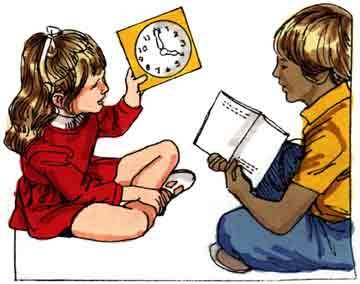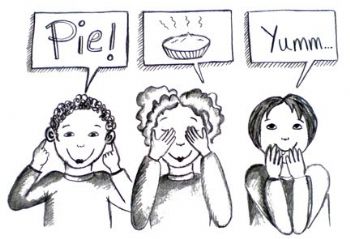Determining Hessa's VAK Learning Style..
Hi all,
Today, i nak share my homework with my readers on my findings.. Asyik update pasal my kids jer.. Hahaha.. Jom, let me share with you on something FOR MY KIDS and yours too.. Harap2, dengan apa yang i baca and share today, dapat bagi benefit to both sides, and insyaAllah, with full support and determination, we able to help our kids learn at their best using the right approach that suits them.. :)) InsyaAllah..
So, yes, for those yang memang follow my blog since last 2 years, you might already come across with my VAK entry too, that i posted during my days to find which approach that suit my Aidan.. :) And yes, by determining his VAK and from my observation, i got to learn that he was (still is actually- sikit2 lagi) actually Kinaesthetic, i introduced him a lot of hands-on activities, and selit juga sekali sekala Visual and Audio but berserta hands gestures, so that he would pick up what he learn even fast.. Alhamdulillah, i got to see improvements even when he was only 1 1/2 y.o.. But, participation of the parents are so crucial.. Hubby and i took turns to go through our teaching material every night.. But not that i am saying that Aidan expert ke apa, just that he got things faster, he remembered them, and he even able to describe what he just saw, sebab bila you come up with hands-on activities, you have to be wise to let him get use with other style of learning too.. So what i did, i asked him a lot of questions, while doing the activities with him, and he then able to reply or answer my questions.. But different kids would act differently.. Just that, we got to know our child.. Get to know them.. :))
Okay, let's get to know Hessa.. This part is for me already.. Hahaha.. If you wish to skip, please skip, and read the findings below.. Hehehehe.. :P
Hessa is truly special.. She likes to immitate, copy and follow whatever Aidan does or say.. That's her, and she likes, like super LIKES to observe things.. Hessa loves books, arts and anything that are colorful and cantik.. :)) But, Hessa is not really patient when it comes to flashcards.. Last night, when i was busying with our laundry, and daddy called Hessa for flashcards, i heard daddy went from one card to another, and this girl sat still and really focus.. Then after cards and cards, i heard her saying 'Nak air???! Jom, nak air??' Hahahaha.. I was laughing inside, as she is special indeed.. :P So, i agree that every kid is different and i can't simply expect the same thing from her.. So, what i did?? HOMEWORK!!
Yes, i read back these findings, and later will start to observe her.. Let me give her some time to really show her personality, likes, dislikes, passions and what not.. Hehehe.. Come on, Hessa! :)) Currently, Hessa able to sing to ABC song, able to count, and recognize only certain animals.. However, this little girl is so banyak cakap, and vocabs memang amat memeranjatkan.. hehehe.. But i need her to focus too.. :))
P/s: Please take note that you are not pressuring your kids to learn.. Who says that Aidan learnt the hard way?? He had a lot of fun, learning.. We just need to create a fun way for him to learn things.. Be smart, make it fun, and the most important thing is, BE WITH THEM.. Support.. :) Ofcoz your effort doesn't guarantee his future, duuuhhh??? But, learning starts from home right?? And it should be, start from you! :) Happy sharing, and happy trying guys! :)
VAK stands for Visual-Auditory-Kinaesthetic. From the findings one can find if he/she is a visual-auditory or kinaesthetic learner.
This article belongs to : PODAR International School..
AUDITORY learner
We are sure you are eager to know your child's learning style, some child strongly displays characteristics of an AUDITORY learner. This simply means your child is more inclined to 'learning by listening'.
We would like to share with you the characteristics of an auditory learner.
People with an auditory learning preference can be divided into two categories.
Auditory tonal, these people are concerned with sounds and voices. They are very good at learning by listening and will respond to certain tones of voice and they will be interested in what you have to say. If someone is auditory learner he/she will say things like, "I hear what you are saying."
Auditory digital are interested in words, you will often find them talking to themselves, and it is important to them that what they say 'makes sense' and they will do a lot of thinking, analysing and rationalising. If someone is auditory digital he/she will say things like, "that makes sense to me."
General Information
•They may move their lips and read out loud. They often do better talking to peer.
•Prefer to hear an explanation of something rather than read about it.
•Find it helpful to record notes of audio cassette and play them back.
•They may have difficulty with reading and writing tasks.
•Are easily distracted by noise.
•Auditory learners often tilt their head to the side when listening and repeat phrases in their minds.
•Enjoy the performing arts and music.
Here's a List of Strategies to Help Auditory Learners Succeed.
Teach reading by having your child:
•Use the phonetic approach.
•Use rhyming word games.
•Read aloud, even when reading independently.
Use auditory materials to teach lessons, including:
•Video tapes.
•Audio tapes.
•Books on tape.
•Melodies, rhythms and beats to reinforce information .
Have your child:
•Answer questions orally.
•Give oral reports.
•Repeat facts aloud with their eyes closed.
•Use repetition to memorize.
•Recite information aloud when they're studying (i.e., facts, spelling words).
•Use tape recorders to record and play back lessons.
•Participate in small and large group discussions before working independently.
•Study in groups.
As Parents, we can also try to give directions verbally, paraphrase key information, provide students a quiet place to do homework, and play music softly in the background, if they prefer.
So, let us break out the tape recorder, the books on tape and those rhyming skills, and maximize our child's learning style while boosting his/her confidence.
VISUAL learner
We are sure you are eager to know your child's learning style, if your child displays characteristics of a VISUAL learner, this simply means your child is more inclined to 'learning by seeing'.
We would like to share with you the characteristics of a visual learner.
People with visual learning preference can be divided into two channels.
Visual- Linguistic : Learners who are visual-linguistic like to learn through written language, such as reading and writing tasks. They remember what has been written down, even if they do not read it more than once. They like to write down directions and pay better attention to lectures if they watch them.
Visual- Spatial : Learners who are visual-spatial usually have difficulty with the written language and do better with charts, demonstrations, videos, and other visual materials. They easily visualize faces and places by using their imagination and seldom get lost in new surroundings.
General Information
•Like to read.
•Are good spellers.
•Memorize things by seeing them on paper.
•Are organized.
•Would rather watch, than talk or do.
•Have good handwriting.
•Notice details.
•Remember faces better than names.
•Have trouble following verbal directions.
•Are easily distracted by noise.
•Doodle on their paper.
Here's a List of Strategies to Help Visual Learners Succeed.
Practice Reading by :
•Putting each letter on a card and askyour child to arrange words.
•Putting words on cards askyour child to arrangeinto sentences.
•Putting sentences on paper strips to teach sequencing and paragraphing.
•Showing the visual patterns in words (i.e., word families).
Practice other subjects by :
•Using visuals to teach lessons, including pictures, graphics, images, charts, outlines, story maps, and diagrams.
•When giving verbal directions write down key words or phrases and use visuals.
•Demonstrate what you want your child to do.
•Use dry erase boards with coloured markers.
•Use colour cues, framing and symbols to highlight key information.
•Encourage your child to write down and highlight key information.
•Encourage the use of flashcards when memorizing (i.e., math facts).
•Provide visual activities, including maps, videos, models, puzzles, matching activities, computers, and word searches.
As Parents, we can help our child use this learning style to her advantage and as their guardians lets maximize motivation both at home and classroom.
KINAESTHETIC learner
We are sure you are eager to know your child's learning style, if your child strongly displays characteristics of a KINAESTHETIC learner, this simply means your child is more inclined to 'learning by experiencing and feeling.'
We would like to share with you the characteristics of a kinaesthetic learner.
People with visual learning preference can be divided into two channels.
Emotional learners : They check out their feelings prior to expressing their thoughts.They will be interested in something if it "feels right".
Tactile Learners : They memorise by doing or walking through something. They respond to physical rewards and touching. Need physical activity to learn.
General Information
•Move around a lot.
•Like to touch people they're talking to.
•Tap their pencil or foot while doing schoolwork.
•Enjoy physical activities.
•Take frequent breaks when studying.
•Do not spend a lot of time reading.
•Have difficulty spelling correctly.
•Like to solve problems by physically working through them.
•Like to try new things.
•Are coordinated and agile.
•Are considered hyperactive.
•Express their feelings physically (i.e., hugging, hitting).
•Move their hands when they talk.
•Dress for comfort, instead of style.
•Lay on the floor or bed when studying.
•Enjoy touching things.
•Have difficulty sitting still for extended periods of time.
•Excel in athletics and the performing arts
Here's a List of Strategies to Help Visual Learners Succeed.
Provide your child with hands-on learning tools, including:
•Abacus (manual math tool with horizontal rods and moveable beads).
•Modelling clay.
•Number lines.
•Models.
•Sandpaper and carpet to trace letters, shapes, and numbers.
•Drawing materials.
•Puzzles.
•Wooden numbers and letters.
•Globes and maps.
•Blocks and cubes.
•Felt boards.
•Computers.
•Geoboards with rubber bands (a square board with vertical and horizontal lines created by pegs used to teach shapes and geometric concepts)
Provide your child with hands-on learning opportunities, including :
•Experiments
•Field trips
•Role playing
•Projects
•Games
Kinaesthetic learners do things differently. But that doesn't' mean they do them worse.
Encourage your child to study in several short blocks of time, instead of one extended time period.
Teach concepts with concrete examples (for example, teach greater than and less than with a crocodile puppet, rather than just numbers on a chalkboard).
Have your child memorize information while moving. They can walk, jump rope, or skip as they're learning the material-- they don't need to sit at a desk, at least at home!
Encourage your child to clap out sounds or syllables they hear in words.
With a little help, kinesthetic learners can find tricks that make the system work in their favor. They just need some motion with their math, some rev with their reading. So let us get brainstorming on getting them on the move!

































































































